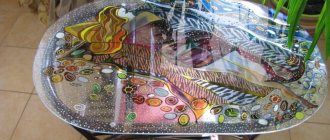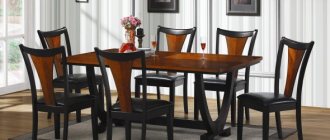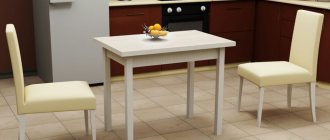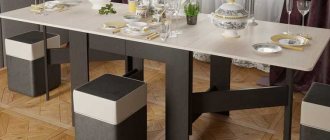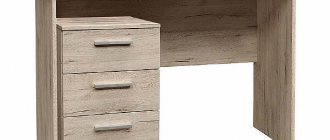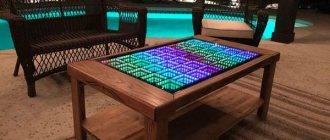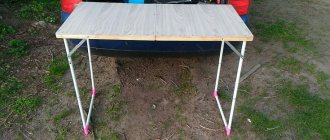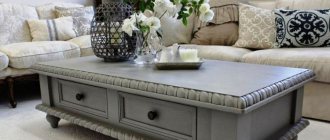Glass
Glass is used in rooms of any size. In addition to transparent models, matte, decorated with images, and tinted ones are available.
However, hand marks, scratches, and dirt are clearly visible on the glass, and for this reason, a round glass table in the kitchen requires constant care and careful handling.
Modern modifications made of tempered glass are durable and safe when broken.
Summing up the results of the round table
This stage is no less important than organizing the discussion itself. It is completely unacceptable to end a lesson in the spirit of: “Thank you for your attention and participation. Everyone learned something useful from the lesson. Goodbye".
At the debriefing stage, the presenter should:
- remind you of the goals that were set at the beginning of the lesson;
- briefly show the final arrangement of participants’ opinions on the basic issues of discussion;
- formulate a general opinion;
- voice aspects that were not adequately covered during the discussion;
- give a task for self-study.
And only then comes the evaluation and words of gratitude.
Tile
The tile has a rather exotic appearance, is heavy, but does not require maintenance and is easy to use.
Methodological recommendations for holding round tables; methodological development
Municipal budgetary preschool institution “Child Development Center - Kindergarten No. 97 “Kuchtәnәch”
Methodological recommendations for holding round tables
Compiled by: Konakova T.A.
Teacher of group No. 12
Nizhnekamsk, 2021
Round tables are one of the most popular formats for conducting scientific events. In essence, the Round Table is a platform for discussion of a limited number of people (usually no more than 25 people; by default, experts, respected specialists in a particular field).
But you should not use the concept of “round table” as a synonym for the concepts of “discussion”, “polemic”, “dialogue”. It is not right. Each of them has its own content, and it only partially coincides with the content of the others. A “round table” is a form of organizing an exchange of opinions. This term does not indicate what the nature of the exchange of opinions will be. In contrast, the concept of “discussion” presupposes that within the framework of the discussion there is a free exchange of opinions (open discussion of professional problems). “Policy” is a special type of discussion, during which some participants try to refute and “destroy” their opponents. “Dialogue,” in turn, is a type of speech characterized by situationality (depending on the situation of the conversation), contextuality (depending on previous statements), a low degree of organization, involuntary and unplanned nature.
The purpose of the Round Table is to provide participants with the opportunity to express their point of view on the problem under discussion, and in the future formulate either a common opinion or clearly distinguish between the different positions of the parties.
Organizational features of round tables: relative cheapness of holding compared to other “open” event formats; lack of a rigid structure and regulations. That is, the organizer has practically no tools for direct influence on the program (you cannot force guests to say what the organizers want), but only indirect ones. For example, you can divide the entire discussion into several semantic blocks, thereby formalizing the structure of the event, but everything that happens within these blocks depends entirely on the host of the Round Table; significant restrictions in terms of the number of visitors; intimate event.
Moderation (conducting).
A key element of any Round Table is moderation. The term "moderation" comes from the Italian "moderare" and means "mitigation", "restraint", "moderation", "restraint". The moderator is the host of the round table. In its modern meaning, moderation is understood as a technique for organizing communication, thanks to which group work becomes more focused and structured.
The task of the presenter is not just to announce the list of participants, identify the main topics of the event and give the start to the Round Table, but to hold in his hands everything that happens from beginning to end. Therefore, the requirements for the professional qualities of Round Table leaders are high.
The presenter must be able to clearly formulate the problem, not let the thought spread out, highlight the main idea of the previous speaker and, with a smooth logical transition, give the floor to the next one, follow the rules. Ideally, the Round Table leader should be impartial.
Do not forget that the moderator is also an actual participant in the Round Table. Therefore, he must not only direct the discussion, but also partially take part in it, focus the attention of those present on the information that is required, or, conversely, try to move the conversation in a new direction as quickly as possible. It should be remembered that the presenter must have the minimum required knowledge on the stated topic.
The moderator of the Round Table should not be:
- Confused and intimidated. Such qualities are typical for novice presenters and are associated with anxiety and lack of practice.
- Authoritarian. The desire to control and regulate the course of discussion to the maximum extent, to maintain strict discipline, is not conducive to discussion. •
- Conniving. The facilitator must focus the discussion on the issues being discussed and concentrate it in time. Connivance on his part will contribute to the activation of alternative leaders who will try to shift attention to themselves. The discussion will begin to move away from the topic and break up into local discussions. • Too active. The task of extracting information requires limiting the activity of the leader.
- Poor listeners. The facilitator's lack of listening skills will result in a lot of useful information being lost from what was said during the discussion. In this case, the more subtle comments received as a result of public discussion, which represent the basis for deepening the discussion, will remain unheeded. The reasons for this behavior may be the desire of the Round Table leader to strictly follow the discussion questionnaire, as a result of which he concentrates his attention on it. Or a concern about effectively listening to everyone in the group without leaving anyone out and giving everyone equal time.
- A comedian. Involves focusing on the entertainment aspect of the discussion more than on its content.
- Exhibitionist. Such a leader uses the group mainly for self-affirmation purposes and puts personal goals above research goals. Narcissism can be expressed in pretentious poses, unnatural gestures and intonations, moralizing and other forms of “working for the public.”
Rules for round table participants:
- the participant must be an expert on the topic being discussed;
- You should not agree to participate in the Round Table just for the sake of the very fact of participation: if you have nothing to say, then it is better to remain silent.
Stages of preparing round tables:
1.Choosing a topic. It is carried out with a focus on the areas of scientific work of the department and teachers. Departments propose topics for “Round Tables” with justification for the need for its discussion and development. In this case, the general rule should be taken into account: the more specifically the topic is formulated, the better. In addition, the topic should be of interest to the audience.
2. Selection of the presenter (moderator) and his preparation. The moderator must have such qualities as communication skills, artistry, and intelligence. Personal charm and a sense of tact are also important. The competence of the presenter plays a special role for the Round Table, therefore the moderator is obliged to independently carry out preparations within the framework of the given topic of the Round Table.
3. Selection of participants and identification of experts for the Round Table. The essence of any Round Table is to attempt a brainstorming session on a specific issue and find answers to some important questions. To do this, it is necessary to gather in one place people who have the necessary knowledge on the issue that requires coverage. These people are called experts or specialists. The initiator needs to identify potential experts who could give qualified answers to questions that arise as part of the discussion of the stated topic of the Round Table. If the scale of the event extends beyond the boundaries of the university, it is advisable at the preliminary stage of preparation of the Round Table to send out information letters and invitations to participate in this event to the intended participants. It should be remembered that the formation of a group of participants requires a differentiated approach: these should be not only competent, creatively thinking people, but also officials, representatives of the executive branch, on whom decision-making depends.
4. Preliminary distribution of questions to prospective participants - carried out 7-10 days before the Round Table;
5. Preparing a questionnaire for the Round Table participants - the purpose of the questionnaire is to quickly and without a lot of time and money to get an objective idea of the opinion of the Round Table participants on the issues discussed. The survey can be continuous (in which all participants of the Round Table are surveyed) or selective (in which part of the Round Table participants are surveyed). When compiling a questionnaire, it is necessary to determine the main task-problem, break it down into components, and assume on the basis of what information it will be possible to draw certain conclusions. Questions can be open, closed, semi-closed. Their wording should be short, clear in meaning, simple, precise, and unambiguous. You need to start with relatively simple questions, then offer more complex ones. It is advisable to group questions according to meaning. Before the questions, there is usually a message to the survey participants and instructions for filling out the questionnaire. At the end, the participants should be thanked.
Preparation of a preliminary resolution of the Round Table. The draft final document should include a statement part, which lists the problems that were discussed by the participants of the Round Table. The resolution may contain specific recommendations to libraries, methodological centers, government bodies at various levels, developed during discussion or decisions that can be implemented through certain activities, indicating the deadlines for their implementation and those responsible.
Methodology for conducting the Round Table.
The round table is opened by the presenter. He introduces the participants in the discussion, directs its course, follows the regulations, which are determined at the beginning of the discussion, summarizes the results, and summarizes constructive proposals. The discussion within the Round Table should be constructive and should not be reduced, on the one hand, only to reports on the work done, and on the other hand, only to critical speeches. Messages should be short, no more than 10-12 minutes. The draft final document is announced at the end of the discussion (discussion), additions, changes, and amendments are made to it.
Options for holding round tables:
- The first option is for participants to make presentations and then discuss them. At the same time, the presenter takes a relatively modest part in the meeting - he distributes the time of speeches, gives the floor to the discussion participants.
- The second option is for the presenter to interview the Round Table participants or put forward points for discussion. In this case, he makes sure that all participants speak out and “keeps” the course of the discussion in line with the main problem for which the round table meeting was organized. This way of conducting the Round Table arouses greater interest among the audience. But it requires greater skill and deep knowledge of the “nuances” of the problem being discussed from the presenter.
- The third option is “methodological gatherings”. The organization of such a round table has its own characteristics. Issues that are essential for solving some key tasks of the educational process are proposed for discussion. The topic of discussion is not announced in advance. In this case, the skill of the Round Table presenter is to invite listeners in a relaxed atmosphere to a frank conversation on the issue under discussion and lead them to certain conclusions. The purpose of such “get-togethers” is to form the correct point of view on a certain pedagogical problem; creating a favorable psychological climate in this group of students.
- The fourth option is “methodological dialogue”. As part of this form of the Round Table, listeners are familiarized with the topic of discussion in advance and receive theoretical homework. A methodological dialogue is conducted on a specific problem between the presenter and listeners or between groups of listeners. The driving force of dialogue is the culture of communication and the activity of listeners. The general emotional atmosphere is of great importance, which allows one to evoke a feeling of internal unity. In conclusion, a conclusion is drawn on the topic and a decision is made on further joint actions.
Presentation of materials from the Round Table.
The most common options for publishing the results of round table discussions are as follows:
- a brief (reduced) summary of all the speeches of the Round Table participants. In this case, the most important thing is selected. The text is given on behalf of the participants in the form of direct speech. At the same time, the host of the Round Table must discuss with the speakers what exactly will be selected for publication from each speech. These rules dictate ethical requirements that must always be observed when working with authors of texts.
- a general summary drawn from the various speeches made during the discussion. In essence, these are general conclusions on the material that was presented during the conversation or discussion of the Round Table.
- a complete summary of all participants' speeches.
Color solutions
When choosing a color, you should follow the basic rule: the color shades of the table should blend well with the surrounding furniture.
A state of peace and psychological comfort is created by light colors: white and beige, which also visually increase the volume of the room.
Note!
U-shaped kitchen: pros and cons of the U-shaped layout. Methods of arranging furniture, dividing into working and dining areas. Photos and videos of design ideasKitchen facades: TOP 180 photos and video reviews of kitchen facades. Types of frames, criteria for choosing materials and color solutions
- Short curtains for the kitchen - features of using short curtains in small and large kitchens. Advantages and disadvantages of fabric materials (photo + video)
If contrasting white and black colors are used in the kitchen interior, then the round table in the kitchen can have a similar color design.
Despite the respectability of a dark-colored table, it is very imprudent to use such colors in this option.
Contrasted with the main color of the decor of the entire kitchen, a dark-colored table made of glass or stone will look original in a white kitchen.
Where to buy a round table?
If the demands of a round table have not deterred you, and you have decided to place this exquisite and original piece of furniture in your kitchen, we can help you with choosing a model. The HomeHit online store has several options for round kitchen tables. In order to become the owner of a round table, you need to leave a request and wait a little. We offer various color options for round tables made from high quality laminated chipboard. An additional bonus for our clients is the opportunity to make a purchase in installments without interest. The store constantly has special offers and promotions, our managers will tell you more about them.
Article prepared by:
Recommendations from experts
When solving the problem of choice, adhere to the following:
- The minimum area occupied by one person at a table is 0.6 x 0.4 m (width and depth, respectively).
- When choosing, you should take into account the number of people living in the house and the maximum number of guests.
- The width of the passage between the table and other furnishings should be at least 0.8 m.
- In a small kitchen, a round table on one leg will save space.
- It is preferable to design a table under which you can put chairs.
- Tables with glass tops visually increase the volume of the room. Choosing a table made of durable tempered glass will preserve its appearance and extend its service life.
- When purchasing a sliding model, you should carefully test the operation of the mechanics. The operation of the mechanism must be trouble-free and silent. There are no gaps when unfolded.
- For square kitchens, a round table is an excellent choice.
- The table when unfolded should fit into the dimensions of the kitchen. If there are not enough seats at the table, you should choose another model.
Note!
Water filter for the kitchen: functions and benefits of a water filter in the kitchen. Types of filters and mechanisms, their pros and cons (photo + video)Kitchen in high-tech style: 135 photos and video master class on organizing space and design
Kitchen in modern style - 160 photos of the best design options and features of the style
Round table in the interior
It was already mentioned above that a round table with chairs is considered the optimal solution for any interior style. Beginning designers can safely choose:
- Wooden model for Scandinavian style.
- A wooden product coated with white paint or artificially aged for an interior in the Provence style.
- Dark massive products for a classic English room.
- Models made of glass or plastic for modern style.
- Forged tables will fit perfectly into the Gothic or loft style.
Advantages of round tables
- Psychologists believe that people sitting at a table of this shape feel more relaxed, which contributes to full communication.
- The absence of sharp corners makes this table more secure. This is especially true for families with young children.
- Saves space in a small kitchen when installed next to a window.
- Compared to rectangular tables, it can accommodate more people.
- It harmonizes with any style trends, including high-tech and classic.
- A table of this shape transforms the kitchen and makes it more attractive.
- A wide selection of colors, materials and textures allows you to satisfy the most unpredictable desires of customers.
The choice will be much easier if, before purchasing, you look at photos of the most successful models of round tables for the kitchen posted on the world wide web.
Round? Or maybe rectangular? Square?
Round table (event) is a phrase that in the twentieth century acquired the meaning of a term that defines the generally accepted format of conferences and meetings at various levels.
The table, its shape, the seating arrangement of the participants, the presence of other attributes in the room (stand, information board, multimedia equipment) depend on the purpose of the meeting.
A conversation at a round table will take place in the most relaxed and equal atmosphere. If the event still requires a leader, a presenter, then it is more advisable to use a square, rectangular or U-shaped negotiation table. It is then headed by a manager or chairman. When a conversation requires a more active process, for example, speakers need to be on the move, have access to everyone present for a personal conversation, transferring data and documents to them, it is necessary to use a table set in a U shape with an open passage, where conference participants can move freely.
Flaws
- A table on one leg is not stable enough.
- Placed against the wall, it does not fit completely.
- Tables placed in a row take up too much space.
- In the case of a small-sized kitchen and a large number of family members, it is not convenient enough to use.
- The mechanics of cheap models are not reliable enough, which makes it impossible for the sliding mechanism to function.
- The number of seats does not exceed six.
Reasons for choosing a round table
When choosing furniture for the kitchen, you need to consider:
- number of people living in the apartment;
- room dimensions;
- layout;
- a number of other important factors.
Wooden table in the kitchen interior
Small family
Round tables are ideal for a family of 3-4 people. With a large diameter of the tabletop (from 130 cm), even 6 people can be seated at them, however, problems may arise with the placement of appliances. There will also be an empty area in the middle of the overall tabletop. It will be quite difficult to reach it.
If the item is purchased for a family with 1–2 children, it is recommended that the tabletop size be at least 120 x 80 cm. In general, for each person sitting at the table there should be 60 cm of width and 40 cm of depth of horizontal space. With this approach, eating, relaxing, and maintaining a conversation will be comfortable.
Small room
When the table does not have corners, it is easier to fit more closely behind it. For a small kitchen or dining room, a round table is perfect. The product will appeal to those who do not like to place appliances in corners. Unfortunately, it is impossible to move round furniture against the wall, which must be taken into account when planning your purchase.
Using a round table in a small kitchen space
Safety
The rounded shape of the table will reduce the risk of domestic injuries, which especially often occurs among children. The absence of corners will make it easier for parents who are trying to keep track of their child's walking. You don’t have to cover the corners of the table with anything; you don’t have to use special plugs.
Room Features
The layout of the kitchen also influences the decision to buy a table. If the shape of the room itself is square, a round table is placed in the middle, leaving plenty of space for furniture and chairs. For an elongated kitchen, rectangular furniture is considered optimal. When installing a table at the exit, it is more convenient to go around the round product, as well as when placing it in a confined space (niche, bay window).
Kitchen table in bay window
Choosing a table for chairs
Round-shaped kitchen chairs can be purchased in advance. For a harmonious look, you have to select the appropriate table for them. For example, chairs on one leg that can rotate around their axis, complete with a “one-legged” table, look stylish.
Types of sliding tables
The following designs are available:
The insert is stored in a drawer under the table top. When the tabletop is extended, the board is inserted between the extended parts of the tabletop.
The insert is located in the center and is divided into two parts, which rotate after the table is extended.
The book-table has a lowered part, which, if necessary, rises and rests on an additional leg attached to the inside of the tabletop. When folded, it moves conveniently against the wall.
An original model that unfolds by rotating a special structure and filling the resulting voids with segments located below.
Unusual designs of round tables
A round kitchen table is most often made in a static version, with a solid tabletop and rigidly fixed legs. However, not all elements of this furniture are made this way, and it is worth talking about unusual designs in more detail.
- It is worth highlighting the extendable round table for the kitchen. When assembled, it is no different from a regular round table - only its tabletop consists of two equal parts. Both segments can be pulled out a certain distance, after which it becomes possible to install a third rectangular segment. Thanks to this, the table takes on the shape of an ellipse, increases in length and, accordingly, a little more people can be seated at it. This option is ideal for people who love to receive guests.
- When disassembled, a folding table with a round tabletop is no different from a regular one. The only innovation in the design is that the legs are attached to the tabletop not rigidly, but movably. The hinges ensuring mobility are equipped with latches. When the table is no longer needed, the legs fold up and the table can be placed sideways close to the wall or hidden in the pantry. This table is extremely good for kitchens and living spaces with limited free space.
- It is impossible not to note the round table of the lifting type. Its design resembles the tables installed in train compartments. The cut semicircular tabletop is attached with its wide part to the wall on hinges, after which it can be lifted and fixed against the wall without effort.
Such an extensive selection of a wide variety of models allows you to quickly and easily select the most convenient model for each individual kitchen space. If a table of the required design is not available in furniture stores in the city, there is always the opportunity to make it to order. Naturally, the price in this case will be slightly higher, but this is a necessary evil when choosing exclusive furniture and when demand exceeds supply. Naturally, a round table requires careful inspection of the build quality, and special attention must be paid to moving elements that may be present in the design. The second most important point that needs to be carefully checked is the unsteadiness of a table with one leg: identifying the maximum permissible load on the edge of the tabletop is extremely important in order to understand how much the table can be overloaded without the risk of it tipping over. After this, it is worth checking the quality of the material and the absence of visible defects.
- home
- About kitchens
- Tips for using a custom kitchen
- Round table for the kitchen: pros and cons
→
→
→

